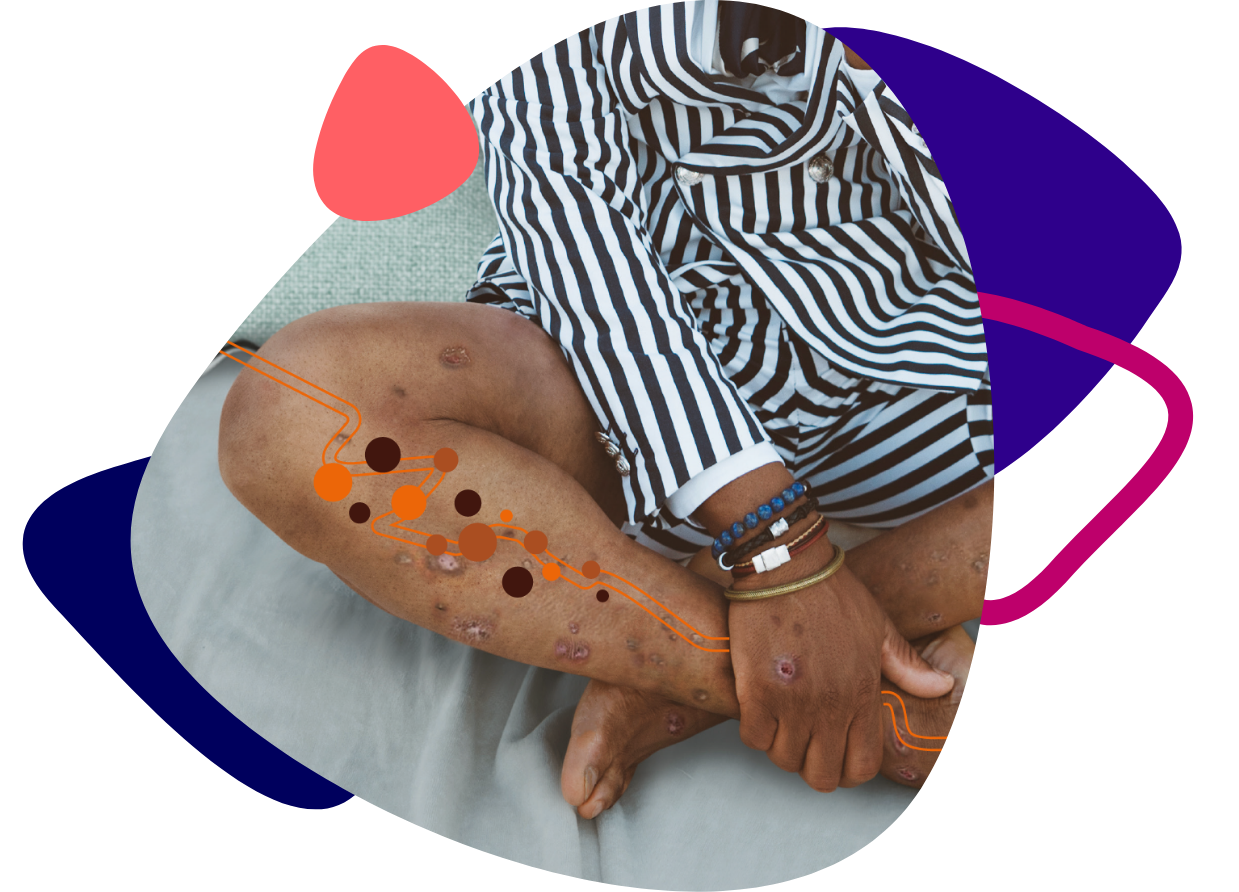
Living with prurigo nodularis
Prurigo nodularis can take its toll on your mental wellbeing. But you’re not alone.
The burden of prurigo nodularis is more than skin deep1,2
Prurigo nodularis (PN) can affect many aspects of your life.1,2 From sleep and everyday tasks to social activities, it may start to take a toll on your mental health.1–4
If you’re feeling this way, it’s important to know that you’re not alone. Many people with PN often struggle with this too.1,4 Below, we’ll look at how its signs and symptoms can impact your mental wellbeing, and point you towards where to find support.
PN can make sleeping a nightmare2,3
Unfortunately, the itch tends to be worse at night, which can make getting a restful sleep feel impossible.2 This is quite common for conditions with chronic itch, and may be due to the body’s circadian rhythm (natural body clock) altering your temperature, skin barrier or hormone levels.5 As a result, you could feel drained of energy the next day – and that can affect your mood too.5

PN can make sleeping a nightmare3,4,6
Living with a chronic (long-term) condition can make having a social life tough.6 At least 1 in 4 people with PN find that they no longer want, or feel able, to engage in social activities.7
PN can sometimes bring about feelings of shame.3,8 This can impact how you interact with others – you may notice that it’s affecting your friendships or causing you to withdraw.9–11
Some people living with PN find that it interferes with school or work.7 For instance, taking more time off compared to classmates or colleagues.7 For some, it means considering early retirement.3,7 This can be especially difficult if you rely on work for a source of income or are leaving a job you enjoy.

Your mental wellbeing matters
Maybe you feel like the itch never goes away, or find that it’s often on your mind.4 The signs and symptoms of PN can put you under a lot of stress and greatly impact your mental health.1,8 In fact, around 1 in 5 people with PN experience mental health conditions like anxiety or depression.1,4,8
If you have PN, it’s important to acknowledge how you’re feeling. Doing so is the first step to finding the support that you not only need, but deserve.

Where to find help
If you notice that PN is affecting any of these areas in your life, it’s essential that you speak to someone and get help. Whether it’s a friend, family member, healthcare professional, counsellor, or another person in your support network, it’s best to share how you’re feeling.
Help is closer than you may think
Take a look at the resources and local support available to you.
It’s also really important to let your doctor or dermatologist know about how your PN is affecting you.
They can use this information to assess the severity of your condition, and tailor a management approach around your experiences.12
Even if you feel lost or haven’t been for an appointment in a while, you should keep checking in with your doctor or dermatologist. There may have been developments in PN since you last spoke.10,13
Living with PN can be tough. But with the right management approach, you may be able to find better control.12,14
The effect of prurigo nodularis goes beyond the skin2,10,14
Causes of prurigo nodularis
Although prurigo nodularis affects the skin, its causes may be related to other factors. See which underlying factors may be significant
Manage and treat prurigo nodularis
In collaboration with a doctor or dermatologist, you can find a way to manage your prurigo nodularis that works best for you
Symptoms
Prurigo nodularis is characterized by severe itching, lumps, swelling, and other skin lesions.8
- Huang AH et al. J Invest Dermatol 2020; 140(2): 480–483.e4.
- Gwillim E et al. Acta Derm Venereol 2021; 101(3): adv00424.
- American Academy of Dermatology Association. Prurigo nodularis: Signs and symptoms. Available at: https://www.aad.org/public/diseases/a-z/prurigo-nodularissymptoms.
Accessed March 2023. - Pereira M et al. J Eur Acad Dermatol Venereol 2020; 34: 2373–2383
- Podder I et al. Int J Womens Dermatol 2021; 7(4), 403–410.
- Van Wilder L et al. BMS Fam Pract 2021;22: 233.
- Todberg T et al. Acta Derm Venereol 2020; 100: adv00119.
- Pereira M et al. J Eur Acad Dermatol Venereol 2018; 32(7): 1059–1065.
- Koutou EA et al. Our Dermatol Online 2021; 3: 244–250.
- Zeidler C et al. Dermatol Clin 2018; 36: 189–197.
- Janmohamed SR et al. Arch Dermatol Res 2021; 313: 669–677.
- Elmariah S et al. J Am Acad Dermatol 2021; 84(3): 747–760.
- Aggarwal P et al. Clin Exp Dermatol 2021; 46(7): 1277–1284.
- American Academy of Dermatology Association. Prurigo nodularis: Diagnosis and treatment. Available at: https://www.aad.org/public/diseases/a-z/prurigo-nodularistreatment.
Accessed March 2023.
Sanofi Belgium, MAT-BE-2400922. V.1. 11/2024
